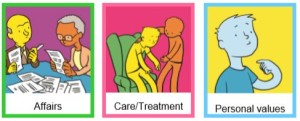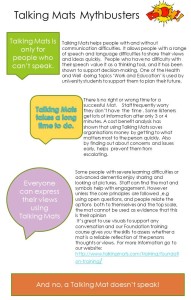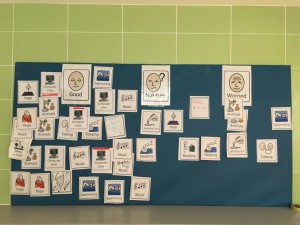Addressing the communication needs of people in youth justice is key to improving lives. The lack of attention to this is costly. On the 17th of April, we organised a seminar to look at the underlying issues and share good practice.
We were delighted with the collaborative mix of people attending. We had representatives from: the Scottish government, the NHS; Third sector organisations working in youth justice, the police, social workers, professional bodies, universities and social work.
Our thanks to Professor Richard Simpson for chairing the day and setting the tone by emphasising from the start that understanding communication is key to improving service delivery. Following his introduction a series of excellent and stimulating presentations took place creating a fusion of ideas and practice from Scotland and New Zealand.
- Kim Hartley Kean, head of the Royal College of Speech and language therapy Scotland office highlighted the current position in Scotland
- Sally Kedge and Alayne Mckee described the approach adopted by their organisation Talking Trouble in New Zealand.
- Jane Macer the therapeutic service co-ordinator from Starley Hall Fife described an whole system approach to embedding good communication practice within an organisation
- Yvonne McKeown and Sandra Polding Speech and Language Therapists working with young people in a NHS inpatient psychiatric unit in Glasgow shared some case examples.
In different ways the speakers brought up very similar themes:
- Communication can be treated glibly. There is a lack of understanding of what communication difficulties are and of the impact that they have on the lives of young people. These difficulties are often hidden and take time to identify. Lack of identification can have a huge impact on the future lives of young people.
- Finding ways to hear the young person’s voice is key both for the young person but also for organisations in order to deliver appropriate and effective care.
- Recognition of the intergenerational cycle and the importance of getting care and support correct so we break patterns and enable change.
- Providing collaborative solutions and understanding the breadth of communication will help services improve. However, given services often don’t know what they don’t know in terms of the impact of communication difficulties we have to find ways to express those solutions in language that those services can relate to and understand. Listening to organisations and exploring their processes by analysing the communicative demands of each stage can be a helpful way to start.
- Moving forward it is important to knock on open doors i.e. work with people who are receptive to recognising the impact of communication difficulties on young people and their lives but also find the strategic influencers who are sympathetic, in the words of our New Zealand colleagues ‘the aunts and uncles in the field’ who can help to promote the issue and raise awareness at a National level.
- You can’t explore the issue of trauma and adverse childhood experiences without certain precursor, building blocks being in place. This takes time and requires a constancy of approach.
- The importance of inclusive, visual tools becoming common place so that they are not used in isolation and in a vacuum.
- The challenge of supporting and nurturing a young person’s inner voice when they have significant difficulties with language.
- Lack of understanding of communication difficulties may lead to services responding to internalized behaviours that can lead to a fork in life; one way can send the young person down a route of offending behaviour services and the other mental health services.
- The solutions lie in partnership and collaboration between professions and services.
There were lots of creative ways of using Talking Mats that were shared. A couple of examples that stand out were
- Using Talking Mats with social workers to help them unpick what they already know about a young person’s language and communication. This approach helped them think about all the different aspects that contribute to communication and where the young person’s strengths and weaknesses lay e.g. non verbal communication , humour , word finding , understanding complex information, understanding simple information etc .
- Using Talking Mats to support a psychiatric assessment of a young person. One person used his Talking Mat to say he was hearing voices something he was unable to disclose verbally. In this case this enabled an accurate mental state assessment and non-custodial sentence.
I will leave the last word to a young man living in an inpatient unit to support his mental health, his words about communication difficulties are ‘They make you more vulnerable when bad stuff happens’ how true that is and this is why it is important we work together to improve services .
Next steps The community justice network met in the afternoon and were challenged to think about the opportunities and barriers in developing services – read the for blog that covers the afternoon ……… If you missed the seminar and want to join a multiagency network to discuss this and help take this forward in Scotland then please let us know .
Click to read the excellent presentations from the seminar
- CJSCENTalkMatsPresentation170418
- Talking Mats presentation 17 April 2018 Sally Kedge Alayne McKee TTANZ final
- TM seminar 04-18
- Talking Mats & Justice CEN April 2018 Draft
Talking Mats in Germany is being extended by one of our trainers Professor Norina Lauer. Here she describes two of her current interesting projects and we look forward to reading her findings.
The German version of the Talking Mats app will now be tested in two more projects in the west of Germany. As the communication symbols were developed for English-speaking clients six German SLT students of the Hogeschool van Arnhem en Nijmegen (han) in the Netherlands want to find out if the words and symbols fit to German clients and their cultural background. Because of cultural differences between Scotland and Germany it is necessary not only to adapt the language but also check the icons.
One of the projects will be conducted with children between the ages of 8 and 10 years. The children will be asked to classify the symbols from their age-group. The question will be whether the symbols and words are relevant for the situation of German children. If not, they will be asked for possible alternatives.
The other project focuses on adults. One group of people with aphasia and one group of healthy persons will be tested. Every tested person scores the 57 icons concerning their correspondence with the words written down below by using a scale from 0 to 3. In addition, possible graphic alternatives will be enquired and collected. The two groups of adults will be used to determine if there is a significant difference between the obtained results from each group.
Talking Mats were delighted to be involved in the launch of Care Opinion’s Picture Supported stories at the Life Changes Trust Gathering in Perth Scotland this week. We have been working with Care Opinion for the past two years to develop this feature. This earlier Talking Mats blog describes the development process and this recent Care Opinion blog gives some examples of the feature in use.
However, in this blog, I want to reflect on two events I went to within a short space of time; the gathering in Perth on Monday and the Royal College of Speech and Language Therapists study day the previous thursday in Stirling . It felt to me like my two worlds colliding or maybe it was just my stars aligning ! At the RCSLT study there was a session on the public perception of Speech and Language therapy and how there is still much work to do in changing the myths that are spun and repeated about what Speech and Language therapists actually do . For as John F Kennedy said in 1962 ‘ the great enemy of truth is very often not the lie but the myth , persistent, persuasive and unrealistic ´ The National Allied Health Professional children’s lead, Pauline Beirne suggested to the study day that Care Opinion is a great web site for encouraging that sharing of stories. Then, strangely when I got back into the office there was a story waiting for me in my in box all about the positive experience of a parent involved in a Hanen programme in NHS Lanarkshire which reinforced that very message.
We know people relate to stories, stories resonate and have impact, they are easy to remember . Our drive in working in partnership with Care opinion was to support more people to tell their health and care stories by increasing accessibility . It was designed with and for people with dementia through funding from Life Changes Trust but anyone can use it and they are! It is great to see the stories coming in.
Through stories let’s celebrate the good, develop and improve practice and let’s use stories to challenge myths and educate. So use Care Opinion and try out the picture supported stories to share your experiences , tell other people ,spread the word and the picture supported story feature !
‘For every pound invested in the Talking Mats Keeping Safe resource and training there is a potential saving to services of £23.00’ .This was the findings of a cost benefit analysis carried out during the development phase of the Keeping Safe Talking Mat resource. A Cost-benefit analysis demonstrates the overall economic value of an intervention with numbers and evidence.
The Keeping Safe resource
The Keeping Safe resource is a visual framework that has been developed and trialled over 6 years in partnership and with funding from various organisations e.g. Survivor Scotland, Scottish government , Kingdome Abuse survivors project and NHS Fife
The Keeping Safe resource provides:
- A listening space for people with learning disability and communication difficulties to raise concerns and express their point of view.
- A structure for staff to find out what people are thinking about their lives, and raise issues that can be difficult to discuss.
A reflective practice training was developed and provided to over 700 staff to allow staff become familiar and confident with using the the resource
Findings of the cost benefit intervention
There is a significant financial advantage to services using Talking Mats. Analysis of six scenarios found that for each pound invested in the Keeping Safe training there is a potential saving to public services of £23.00. In learning disability services it is easy for costs to accelerate quickly. If services don’t respond effectively, challenging behaviours can escalate and relationships and placements are at increased risk of breakdown. Talking Mats can help provide staff with a comprehensive and accessible framework to help them listen to people who can find it difficult to articulate what is really going on for them e.g. issues of pain, relationships or levels of support. In this project 89% of Talking Mats resulted in staff learning new information about the person they were working with, even when they thought they knew them well. The Talking Mats framework provides a way to turn these points of views into actions that can be monitored and reviewed. It is these early interventions that not only save money but improve quality of life.
Cost benefit Process
With support from Inspiring Scotland a cost benefit analysis was done that examined the cost of the Talking Mats intervention and any resulting actions. 6 cases were chosen from over 100 detailed descriptions of how practitioners working with people with learning disabilities had used the resource. These descriptions represented a cross spectrum of people with learning disabilities in Scotland in terms of living situations e.g. living at home , in supported settings and an inpatients facility . They were also chosen to represent the comorbid conditions that often exist with learning disability e.g. autism, mental health and cerebral palsy. An alternative scenario was created and tested with critical friends as to the likelihood of what might have happened without the Talking Mats intervention. All the scenarios that were developed are available here 20180110 scenarios cost benefit The primary source of financial information and the subsequent calculations was the Unit Costs of Health and Social Care produced by the Personal Social Services Research Unit (PSSRU) 2015/16 . This contains detailed cost estimates for a range of services such as care placements, NHS services, social work, mental health, and family interventions. This analysis can only be illustrative as assumptions are subjective.
The findings from our final report 160512 Keeping Safe report 2013-2016 showed that effective use of the resource not only led to improvements to quality of life for individuals but that it can save services money. Book a place on our webinar and get the Keeping Safe resource 20180122 Keeping Safe Webinar or if face to face discussion is more your thing attend the advanced course in April 2018 – you get the resource with that booking too!
This new resource has been developed by Strathcarron Hospice and Talking Mats to help people with advanced illness or long term conditions to think ahead and plan for the future.
It consists of a booklet and 3 topic symbol sets: Affairs; Care/treatment; Personal values
It can be used to help people have conversations about:
• the extent to which their personal affairs are sorted;
• what they would or would not consider about future treatments and care;
• what is going well/not going well in relation to their personal values
It is widely recognised that having discussions about end of life issues can enable people to remain in control for longer and help them to identify the care and support they need and want as they approach death. In spite of this, in Scotland:
- 74% of people have not discussed what their wishes would be if they did not have long to live
- 79% of people don’t have any written plans for their end of life care, financial wishes or funeral plans
- Only 35% of people have written a Will
It can sometimes be difficult for people to start conversations about planning for end of life and people this is exacerbated if people have specific difficulties communicating their thoughts and feelings because of symptoms, fatigue and emotional factors. Before initiating this type of conversation it can be helpful to check the extent of a person’s understanding of their illness and whether or not they want to talk about the future.
The importance of having conversations and making plans for end of life has been highlighted as being relevant for people in the early stages of life limiting illness as well as for those nearing the end of life. There is evidence that people who have Advance or Anticipatory Care Plans in place are more likely to receive the care that they want and treatment can be less invasive. ACP is a process rather than a one-off conversation. It is acknowledged that ACP discussions should take place in appropriate settings with sufficient time to enable to people to consider and weigh up different options. ACP should also be developed in line with peoples’ personal values and goals (Sinuff Tasnim, et al.(2015) “Improving end-of-life communication and decision making: the development of a conceptual framework and quality indicators.” Journal of pain and symptom management 49.6 2015): 1070-1080).
Perhaps we should think about planning ahead whether or not we have advanced illness or long term conditions??
Training
To get the most out of the resource we run half day advanced training courses which will include the Thinking Ahead Resource. This course will be relevant to you if you:
- have attended a Talking Mats foundation training and are experienced in using Talking Mats with adults
- want to extend your use of Talking Mats and consider its role and application to advance care planning
- want to discuss sensitive topics around end of life care
Please contact us at 01786 479511 if you are interested in future dates.
Do you want to introduce Talking Mats to people with a communication disability and autism, but know they will need support to learn it?
We are holding a 2 hour seminar on the 1st of February in Stirling to share ways of supporting people with autism to learn to use Talking Mats and express their thoughts.Twilight ASD Seminar
Do you want to help people think about the future and what they might want to have in place at end of life? Talking Mats and Strathcarron Hospice have developed a powerful new resource to support these sensitive conversations and an advanced course is being held in Stirling on the 21st February and in London 27th of March http://www.talkingmats.com/training/specialist-seminars/
These opportunities are only open to people who have attended Foundation training
Get involved in choosing a Communication Access UK Symbol , and set the standards to go with it!
In early 2017 Communication Matters[1] found out that –
- People with communication difficulties don’t always get the support they need in the community.
- People would like a Communication Access symbol in the UK. Businesses already use some symbols e.g
A small group of people were asked to choose a symbol to represent Communication Access. 2 ideas were very popular. For an organisation to display this communication symbol it will mean the staff have been trained to support communication and that the business meets certain standards
Communication Matters now want to hear from more people, with and without communication difficulties.
To have your say about 1) the symbol and 2) the standards to support communication follow this link. http://www.talkingmats.com/wp-content/uploads/2017/12/Communication-Access-UK-Symbols-and-Standards.pdf You will find the symbol choice and a Talking Mat to decide what is important to include in the Communication Access Standards. Send your responses to Communication Matters
Email : admin@communicationmatters.org.uk
Or post : Communication Matters, 3rd Floor, University House, University of Leeds, LEEDS, LS2 9DF
[1] http://www.communicationmatters.org.uk/
Do you need training to use Talking Mats ?
Talking Mats is an effective but deceptively simple tool so a question we are often asked is do you need training to use it. Communication and supporting people with communication difficulties is a complex process and Talking Mats is based on a number of research projects which examined who could use Talking Mats, and how best to use it in different situations. It is therefore important that the integrity of the Talking Mats model is maintained and that Talking Mats training teaches the principles developed from our evidence base.
All our trainers are registered with Talking Mats and provide high quality training based on robust research findings. Only trainers accredited by Talking Mats are eligible to train others.
Some of these principles include:
- Understanding who can and who cannot benefit from using Talking Mats
- Asking open questions
- Handing over control
- Pacing
- Maintaining neutrality
- Interpreting additional information including both non-verbal and verbal information
- Matching the top scale to the question or view being explored
- Presenting the options in an order that maximises the individuals ability to respond by using our model which focuses on concrete to abstract symbols
- Monitoring language complexity and topic sensitivity
All our training courses include hands-on practice and video examples as well as reflection on all these aspects of using Talking Mats
The techniques used in Talking Mats accord with best practice guidance in semi –structured interview techniques including:
- being clear in what you want to find out and using open questions
- enabling elaboration in whatever form is appropriate
- planning in advance but in a context that is flexible and can respond to the dynamics of the conversation
- being cognisant of the influence of the environment
- taking time to establish engagement and rapport
- being non-judgemental
- supportive of periods of silence
- ensuring there is a summary at the end so that both parties agree on what was said .
So whilst Talking Mats may seem simple, it is not simplistic. The listener is creating a space that enables the thinker to think and express themselves. Training gives the listener time to reflect on the components of an effective Talking Mats conversation and identify which ones they are already skilled in and which ones they need to develop further. There are no short cuts to reflective practice training and we know Talking Mats foundation training has impact. Time and time again people who thought they knew about Talking Mats reflect and say things like ‘I got so much more from this training than I expected’ or ‘ I now see I can use Talking Mats for so many different conversations not just ’ I like’ , ‘I don’t like’ ‘or ‘I have been using Talking Mats but now feel much more confident to use it and to make my own submats’

This is why we put so much emphasis on training. We have developed our successful “Train the trainer” scheme to ensure that quality is maintained and reflective practice maintained. If Talking Mats is passed by word of mouth then key aspects of the framework are missed and/or misinterpreted which in turn lessens its effectiveness and impact.
People who come on training are often excited, want to tell colleagues and share it with others. Demonstration and sharing is fine, but it is important to be aware of the difference between sharing and training.
Sharing can often be appropriate especially when there is a team of people supporting the person or parents are keen to see how it works. You can show someone how to use a Talking Mat about a specific conversation. We call this a ‘demonstrating model’. It is helpful to give the listener the words to say to go with it. That way you are enabling other colleagues or family members to have an effective but specific conversation only.
If they then want to use it for other conversations we would strongly recommend they go on to attend the training. Attending a foundation course will enable them:
- to get more out of the technique
- to understand more about their own communication
- to become creative in their use of Talking Mats whilst still adhering to the research principles
- to be able to create their own mats or explore a topic in more depth using submats
So do you need training to use Talking Mats ? The answer is a resounding yes . Training supports you to be an effective Talking Mats listener and get the most out of this versatile communication framework. So if you have not attended a course check out our course opportunities.
https://www.talkingmats.com/training/foundation/
There are a few myths around about Talking Mats. What does it do? – It supports communication and it doesn’t replace a person’s existing modes of communication, be that speech, signing, a symbol book, a voice output communication device or app. Talking Mats works alongside these modes to help people communicate even more effectively about a particular topic.
Some more myths busted! Click on the picture to make it clearer.
Thanks to Rosie Murray for this great blog describing how she used a collaborative Talking Mats ‘Wall’ to help students comment on how different activities inside and outside college make them feel.
As a student, I trained in the Talking Mats approach, after finding it incredibly useful in clinical placements. I am now a speech and language therapist at St John’s College in Brighton. This is a college for young adults with autism, learning disabilities and SEBD. Our learners have a wide range of communicative needs and cognitive abilities. I was approached by our nursing team in the lead up to world mental health awareness day, as they were organising a ‘tea and talk’ session for our learners of all abilities.
We organised a range of activities, such as symbolised conversation starters. However, we felt we needed something to allow our less verbal learners to make their voices heard. I thought back to my training, and remembered Joan Murphy talking about large, collaborative Talking Mats – or ‘talking walls’. We discussed this idea, and felt it would be a great way for students to feedback on how different activities inside and outside college make them feel.
It took some considerable planning. Due to the emotional needs of some students, our top scale required us to avoid words that were too upsetting for individuals. In the end we settled on ‘good’ (with a widget ‘calm’ symbol) and ‘worried’. We also wanted it to provide a genuine opinion, so although we considered including activity options that were clearly negative, e.g. ‘fire alarms’, we took the opportunity to show our learners that we all have different opinions on things, and that this is good. We hypothesised that because of this, learners would be skewed towards giving positive opinions, and this informed the order of presentation of the top scale and the activities themselves.
On the day, we had 15 different activities to give an opinion on, each with different border colours for differentiation, and of course blank tiles so our learner’s could come with their own activities. Students were encouraged to write their name on the back of a chosen activity, and a consistent script was used to present the wall to each learner. Makaton signing was used alongside the script to support understanding.Learners of all abilities offered their opinion, and it generated discussion between learners of differing abilities. It signposted staff to particular likes and dislikes of learners, and showcased the power of talking mats to all staff. For example, one of our learners is a cheerful young man, who uses minimal verbal utterances to communicate. When the board was presented to him, he very clearly selected ‘talking’ as an activity, and clearly indicated that it makes him worried. This has allowed us to reflect as a staff team about how we can support him to communicate with minimal anxiety.
Learners too took away some important lessons from using the wall. They saw that while some activities are VERY popular (e.g. computer time), some are quite polarised, e.g. animals. This highlights the important issue of mutually respecting each others differences. Since the event, staff have discussed ideas they have on how to utilise this tool. We are considering how we could use Talking Mats as a tool in our peer mentoring sessions between learners of higher and lower verbal ability, as we feel it would be beneficial for both mentee and mentor. We are looking forward to using Talking Mats as a flexible tool for the college in the future.
Please let us know of any other innovative ways of using Talking Mats!
 Online training login
Online training login 








